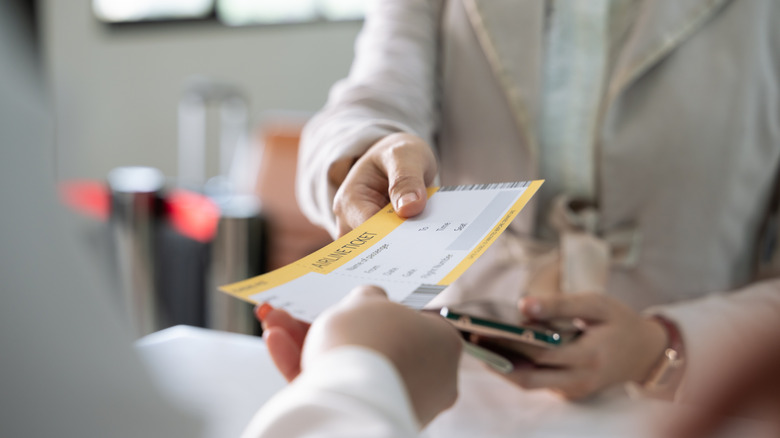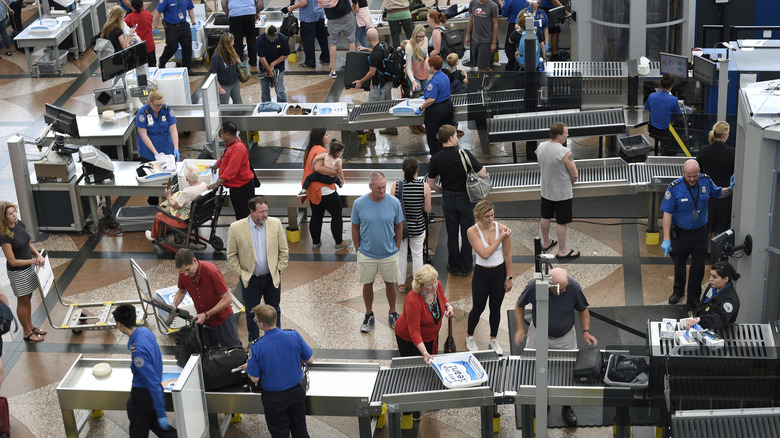Here's What It Means If You Ever See These 4 Letters Repeated On Your Boarding Pass
Checking in early for your flight can smooth out the stress of flying. You'll not only have one less line to wait in at the airport, but you'll also have your seat assignment, allowing you to proceed to the bag drop or the TSA checkpoint. While checking in online is normally done with a few clicks or taps on your screen, there's one holdup that will likely prevent you from checking in on your phone: being flagged for extra security before you arrive. You'll know this is happening to you if you arrive at the airport and are given a boarding pass with a specific four-letter code.
The Transportation and Security Administration (TSA), responsible for security at U.S airports, manages a watch list created after September 11, 2001, to combat terrorism in the United States. Airlines in the U.S. are required by law to forward some of each passenger's information, including their name, date of birth, sex, and routing, to the TSA as part of the agency's Secure Flight program, where their information is matched across TSA's threat list.
Since threats can change daily and TSA agents need to be ready at all times, some passengers will randomly have an SSSS, standing for "Secondary Security Screening Selection," on their boarding pass to signal that they require extra screening — even if they pose no threat. For travelers, TSA does not publish how or why passengers are chosen; however, many flyers believe that they were selected due to having the same name as someone on the watch list, having international one-way or open-jaw tickets, or visiting a country that the State Department deemed a risky destination, including parts of Mexico or the beautiful Turkish "Turquoise Coast." It does not mean that you are a suspect.
What if I have 'SSSS' on my boarding pass?
If you have what TSA calls a "quad" on your boarding pass, you'll have to go through additional security at the airport before boarding your flight. Normally, it doesn't take more than a few extra minutes, but it can add half an hour or more in some cases. If your flight departs from within the U.S., you'll get extra time in security, will likely receive a pat-down, and may have to power up your electronics. Don't be alarmed if a TSA agent also swabs your hands; they're checking for traces of chemicals and explosives, not drugs. Depending on where you are going, you may also be asked a few questions about your trip. From personal experience, I've been flagged flying back from the Middle East and had to power on all of my electronics before boarding. Then, once I landed, I was thoroughly checked by customs to make sure I hadn't brought anything illegal.
While having "SSSS" on your boarding pass is annoying, it's not likely something you'll have to deal with every time you fly on future trips. If you're continually being flagged to visit grandma, you can apply for a TSA Redress Number through the DHS TRIP program. Once you are approved, be sure to add this information to your reservations. Another potential solution is to enroll in the State Department's Smart Traveler Enrollment Program (STEP) before going abroad, which will keep you in the loop for potential security risks in your destination country and may prevent you from being flagged.
Take care of your boarding passes
If you can't check in for your flight online, be sure to check your airline's required check-in times to minimize the risk of another potential wrench in your travel plans by being bumped from an overbooked flight or losing your seat to a standby passenger. Once you're looking at your boarding pass, check the sequence number, identified as "SEQ," followed by a number. If the flight is overbooked, the passengers with the highest sequence number (the last to check in) will normally be denied boarding first.
After your flight, you might be tempted to throw your boarding pass away. However, before tossing it into the trash can, take a few seconds to tear it into pieces (or shred it), as your personal information can be accessed directly through your boarding pass. While no one can use your old boarding pass to fly, the critical six-digit PNR code (the confirmation number you punch in a kiosk) and the barcode on your boarding pass are channels to communicate with the airline's computer system. If someone scans the barcode with a free QR code scanner from their phone, they can access your personal information embedded into the boarding pass, including your frequent flyer number and ticket number. This information can then be used to target you in a cyber attack, such as a fake survey.
If your string of bad luck continues on the way to the airport, most major airlines have a flat-tire rule and will try to book you on another flight, if needed. If you're going to miss the in-person check-in cut-off time, call the airline and let them know your plight. Otherwise, you may be marked as a "no-show" and will have to buy a new ticket.


